Muriel Spark is a modern Scottish writer with a lot of different faces. Her work is very faceted and full of new ideas. This is the reason why she has a huge impact on Scottish literature. As a feminist writer she has developed her own style to cope with literature.
These remarks may lead to the conclusion that Spark’s fiction is an attempt to post-modern literature, which defines itself as breaking with old traditions and finding completely new ways of narrating and mixing reality with fiction. It may not at least be the reason for her novels being so popular since the time Spark started writing them in the late 1950s. In this paper special interest is drawn on Jean Brodie, the protagonist inThe Prime of Miss Jean Brodie(1961) because she is one of Spark’s most discussed characters. First, there will be given biographical details to illustrate parallels between the fictional story and the author’s life. Then the plot of the novel will be summarized to build a basis for investigation and to avoid complicated explanations in the following interpretation of the fictional figure. Jean Brodie as a literary character will be looked at from different angles. First, the origins of the character will be searched in Muriel Spark’s biography, and than the fictional person will be investigated on the background of the novel. The aim is to show that Spark created a very strong female character in the first place, which, in second place, loses power during the course of the novel due to exactly her extraordinary strong characteristics.
Inhaltsverzeichnis (Table of Contents)
- Introduction
- Main Part
- On Muriel Spark
- The Prime of Miss Jean Brodie
- Plot
- Jean Brodie
- The origins
- An extraordinary teacher
- The downfall of Jean Brodie's power
- Conclusion
- Outlook
Zielsetzung und Themenschwerpunkte (Objectives and Key Themes)
This paper aims to analyze the character of Jean Brodie in Muriel Spark's novel "The Prime of Miss Jean Brodie." The focus will be on the origins of the character in Spark's own life and how her extraordinary qualities contribute to her downfall within the novel. The paper will explore how Jean Brodie's life reflects Spark's own experiences as a writer and a woman.
- The influence of Muriel Spark's own life and experiences on her fictional characters.
- The portrayal of a strong female character and her subsequent loss of power.
- The exploration of themes of education, freedom, and the complexities of identity.
- The analysis of Spark's writing style and her use of narrative techniques.
Zusammenfassung der Kapitel (Chapter Summaries)
The introduction provides an overview of Muriel Spark's writing style and her impact on Scottish literature. It highlights the themes of ethical and philosophical questions, unexpected events, and the exploration of good and evil present in her works. The first chapter delves into Spark's biography, specifically focusing on her childhood and youth, drawing parallels between her life and the characters in "The Prime of Miss Jean Brodie" and "The Girls of Slender Means." It explores how her personal experiences, particularly her time at school and the influence of her teacher Christina Kay, shaped her literary creation.
The second chapter delves into the novel "The Prime of Miss Jean Brodie," focusing on the main character Jean Brodie. The chapter summarizes the plot, highlighting key events and relationships. It then examines the origins of Jean Brodie's character in Muriel Spark's biography and analyzes her personality as a strong, influential teacher. The chapter concludes by exploring the downfall of Jean Brodie's power and how her extraordinary qualities ultimately lead to her demise.
Schlüsselwörter (Keywords)
The key terms and concepts explored in this paper include Muriel Spark, Scottish literature, feminist writing, Jean Brodie, The Prime of Miss Jean Brodie, education, identity, female characters, power dynamics, and the influence of personal experience on fiction.
- Citation du texte
- Conny Schibisch (Auteur), 2000, Muriel Spark's Jean Brodie, Munich, GRIN Verlag, https://www.grin.com/document/66876



